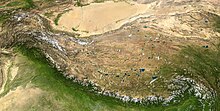

The following outline is provided as an overview of and topical guide to Tibet:
Tibet is a plateau region in Asia and the home to the indigenous Tibetan people. With an average elevation of 4,900 metres (16,000 ft), it is the highest region on Earth and is commonly referred to as the "Roof of the World."
A unified Tibet first came into being under Songtsen Gampo in the 7th century. From the early 17th century until the 1959 uprising, the Dalai Lamas (Tibetan Buddhist spiritual leaders) were, at least nominally,[1] heads of a centralised Tibetan administration, with political power to administer religious and administrative authority[1] over large parts of Tibet from the traditional capital Lhasa. They are believed to be the emanations of Avalokiteśvara (or "Chenrezig" [spyan ras gzigs] in Tibetan), the bodhisattva of compassion.
- ^ a b The historical status of the Dalai Lamas as actual rulers is disputed. A. Tom Grunfeld's The Making of Modern Tibet, p. 12: "Given the low life expectancy in Tibet it was not uncommon for incarnations to die before, or soon after, their ascendancy to power. This resulted in long periods of rule by advisers, or, in the ease of Dalai Lama, regents. As a measure of the power that regents must have wielded it is important to note that only three of the fourteen Dalai Lamas have actually ruled Tibet. From 1751 to 1960 regents ruled for 77 percent of the time"
© MMXXIII Rich X Search. We shall prevail. All rights reserved. Rich X Search
